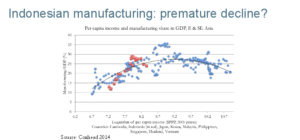Reported by Adinda Rizky Herdianti
On 5 May 2017, Rashesh Shrestha (ANU Indonesia Project) was speaker for the first FKP seminar hosted by Lembaga Demografi (Demographic Institute) presenting on the topic of job displacement, which, based on many past studies, is a common occurrence in developing economies including Indonesia.
The term ‘job displacement’ refers to involuntary job loss due to a specific condition occurring in an economy. Early literature on advanced economies puts emphasis on cyclical and frictional unemployment as the major contributor to displacement, followed by causes related to limited labor mobility and loss of sector specific human capital. However, job displacement is an integral part of a sustained economic expansion, particularly in the presence of rapid technological advancement which eventually replaces decaying specific skills. However, considering over 75% of workers in Indonesia is hired by informal employer, the absence of comprehensive job security system puts a large fraction of Indonesian labor force up in constant risk of earning shocks caused by job displacement. On the other hand, the share of main resources products in exports rose from 32% to 46%, causing manufacturing sector to experience premature decline. Comparatively higher income in main resource production results in flourishing labor-intensive and low-skilled service sector and many workers in manufacturing sector are apparently on the verge of being laid off.
This study aims to provide evidence to a much agreed upon statement that is switching out of formality would cutback the worker’s welfare by comparing the income of those who stayed in the formal sector and those who were displaced, using Indonesian Family Life Survey (IFLS) 2000, 2007 & 2014. The sample consists of formally employed males, including those who withdrew from formal employment. The study splits the sample into two timeframes: 2000-2007 and 2007-2014 to better capture the effect of time factor given the condition of the Indonesian economy. It is reflected partly in the higher number of formality rate in 2014 (34%) compared to 2000 (26%). The extension of basic education program from 6 years to 9 years of schooling also altered the labor market composition with regard to the educational attainment of the workers. As the data shows, in 2000 male workers with primary school education dominated the formal job sector, only second to high-school educated ones, while 7 years later many formal jobs preferred to employ those who have completed at least 12 years of schooling or higher education graduates.
It is found that a worker who is staying in the formal sector job enjoys higher earnings growth over the course in both 2000-2007 and 2007-2014. The relatively higher rate of growth in earnings contributed to the widening gap of earnings between those who stayed in formal sector jobs and displaced workers. The degree of impact is evidently higher in the 2007-2014, showing that working in the informal sector gives less benefit to the workers when the economy is growing. However, Rasesh suggested exercising a more extensive study on this issue, particularly in determining the role of selection criteria of staying in the formal sector.





